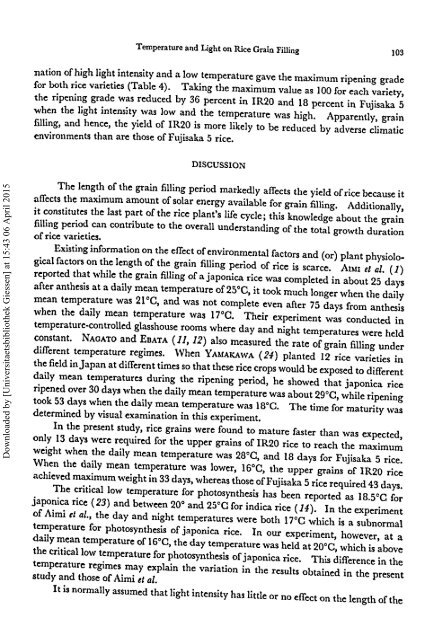Yoshida und Hara - 1977 - Effects of air temperature and light on grain fill
Yoshida und Hara - 1977 - Effects of air temperature and light on grain fill
Yoshida und Hara - 1977 - Effects of air temperature and light on grain fill
You also want an ePaper? Increase the reach of your titles
YUMPU automatically turns print PDFs into web optimized ePapers that Google loves.
Temperature <str<strong>on</strong>g>and</str<strong>on</strong>g> Light <strong>on</strong> Rice Grain Filling 103<br />
nati<strong>on</strong> <str<strong>on</strong>g>of</str<strong>on</strong>g> high <str<strong>on</strong>g>light</str<strong>on</strong>g> intensity <str<strong>on</strong>g>and</str<strong>on</strong>g> a low <str<strong>on</strong>g>temperature</str<strong>on</strong>g> gave the maximum ripening grade<br />
for both rice varieties (Table 4). Taking the maximum value as 100 for each variety,<br />
the ripening grade was reduced by 36 percent in IR20 <str<strong>on</strong>g>and</str<strong>on</strong>g> 18 percent in Fujisaka 5<br />
when the <str<strong>on</strong>g>light</str<strong>on</strong>g> intensity was low <str<strong>on</strong>g>and</str<strong>on</strong>g> the <str<strong>on</strong>g>temperature</str<strong>on</strong>g> was high. Apparently, <strong>grain</strong><br />
<strong>fill</strong>ing, <str<strong>on</strong>g>and</str<strong>on</strong>g> hence, the yield <str<strong>on</strong>g>of</str<strong>on</strong>g> IR20 is more likely to be reduced by adverse climatic<br />
envir<strong>on</strong>ments than are those <str<strong>on</strong>g>of</str<strong>on</strong>g> Fujisaka 5 rice.<br />
DISCUSSION<br />
Downloaded by [Universitaetsbibliothek Giessen] at 15:43 06 April 2015<br />
The length <str<strong>on</strong>g>of</str<strong>on</strong>g> the <strong>grain</strong> <strong>fill</strong>ing period markedly affects the yield <str<strong>on</strong>g>of</str<strong>on</strong>g> rice because it<br />
affects the maximum amount <str<strong>on</strong>g>of</str<strong>on</strong>g> solar energy available for <strong>grain</strong> <strong>fill</strong>ing. Additi<strong>on</strong>ally,<br />
it c<strong>on</strong>stitutes the last part <str<strong>on</strong>g>of</str<strong>on</strong>g> the rice plant's life cycle; this knowledge about the <strong>grain</strong><br />
<strong>fill</strong>ing period can c<strong>on</strong>tribute to the overall <str<strong>on</strong>g>und</str<strong>on</strong>g>erst<str<strong>on</strong>g>and</str<strong>on</strong>g>ing <str<strong>on</strong>g>of</str<strong>on</strong>g> the total growth durati<strong>on</strong><br />
<str<strong>on</strong>g>of</str<strong>on</strong>g> rice varieties.<br />
Existing informati<strong>on</strong> <strong>on</strong> the effect <str<strong>on</strong>g>of</str<strong>on</strong>g> envir<strong>on</strong>mental factors <str<strong>on</strong>g>and</str<strong>on</strong>g> (or) plant physiological<br />
factors <strong>on</strong> the length <str<strong>on</strong>g>of</str<strong>on</strong>g> the <strong>grain</strong> <strong>fill</strong>ing period <str<strong>on</strong>g>of</str<strong>on</strong>g> rice is scarce. An.n et al. (1)<br />
reported that while the <strong>grain</strong> <strong>fill</strong>ing <str<strong>on</strong>g>of</str<strong>on</strong>g> a jap<strong>on</strong>ica rice was completed in about 25 days<br />
after anthesis at a daily mean <str<strong>on</strong>g>temperature</str<strong>on</strong>g> <str<strong>on</strong>g>of</str<strong>on</strong>g> 25°C, it took much l<strong>on</strong>ger when the daily<br />
mean <str<strong>on</strong>g>temperature</str<strong>on</strong>g> was 21 °C, <str<strong>on</strong>g>and</str<strong>on</strong>g> was not complete even after 75 days from anthesis<br />
when the daily mean <str<strong>on</strong>g>temperature</str<strong>on</strong>g> was 17°C. Their experiment was c<strong>on</strong>ducted in<br />
<str<strong>on</strong>g>temperature</str<strong>on</strong>g>-c<strong>on</strong>trolled glasshouse rooms where day <str<strong>on</strong>g>and</str<strong>on</strong>g> night <str<strong>on</strong>g>temperature</str<strong>on</strong>g>s were held<br />
c<strong>on</strong>stant. NAGATO <str<strong>on</strong>g>and</str<strong>on</strong>g> EBATA (11, 12) also measured the rate <str<strong>on</strong>g>of</str<strong>on</strong>g> <strong>grain</strong> <strong>fill</strong>ing <str<strong>on</strong>g>und</str<strong>on</strong>g>er<br />
different <str<strong>on</strong>g>temperature</str<strong>on</strong>g> regimes. When YAMAKAWA (24) planted 12 rice varieties in<br />
the field in Japan at different times so that these rice crops would be exposed to different<br />
daily mean <str<strong>on</strong>g>temperature</str<strong>on</strong>g>s during the ripening period, he showed that jap<strong>on</strong>ica rice<br />
ripened over 30 days when the daily mean <str<strong>on</strong>g>temperature</str<strong>on</strong>g> was about 29°C, while ripening<br />
took 53 days when the daily mean <str<strong>on</strong>g>temperature</str<strong>on</strong>g> was 18°e. The time for maturity was<br />
determined by visual examinati<strong>on</strong> in this experiment.<br />
In the present study, rice <strong>grain</strong>s were fo<str<strong>on</strong>g>und</str<strong>on</strong>g> to mature faster than was expected,<br />
<strong>on</strong>ly 13 days were required for the upper <strong>grain</strong>s <str<strong>on</strong>g>of</str<strong>on</strong>g> IR20 rice to reach the maximum<br />
weight when the daily mean <str<strong>on</strong>g>temperature</str<strong>on</strong>g> was 28°C, <str<strong>on</strong>g>and</str<strong>on</strong>g> 18 days for Fujisaka 5 rice.<br />
When the daily mean <str<strong>on</strong>g>temperature</str<strong>on</strong>g> was lower, 16°C, the upper <strong>grain</strong>s <str<strong>on</strong>g>of</str<strong>on</strong>g> IR20 rice<br />
achieved maximum weight in 33 days, whereas those <str<strong>on</strong>g>of</str<strong>on</strong>g> Fujisaka 5 rice required 43 days.<br />
The critical low <str<strong>on</strong>g>temperature</str<strong>on</strong>g> for photosynthesis has been reported as IS.5°C for<br />
jap<strong>on</strong>ica rice (23) <str<strong>on</strong>g>and</str<strong>on</strong>g> between 20° <str<strong>on</strong>g>and</str<strong>on</strong>g> 25°e for indica rice (14). In the experiment<br />
<str<strong>on</strong>g>of</str<strong>on</strong>g> Aimi et al., the day <str<strong>on</strong>g>and</str<strong>on</strong>g> night <str<strong>on</strong>g>temperature</str<strong>on</strong>g>s were both 17°0 which is a subnormal<br />
<str<strong>on</strong>g>temperature</str<strong>on</strong>g> for photosynthesis <str<strong>on</strong>g>of</str<strong>on</strong>g> jap<strong>on</strong>ica rice, In our experiment, however, at a<br />
daily mean <str<strong>on</strong>g>temperature</str<strong>on</strong>g> <str<strong>on</strong>g>of</str<strong>on</strong>g> 16°0, the day <str<strong>on</strong>g>temperature</str<strong>on</strong>g> was held at 20°C, which is above<br />
the critical low <str<strong>on</strong>g>temperature</str<strong>on</strong>g> for photosynthesis <str<strong>on</strong>g>of</str<strong>on</strong>g> jap<strong>on</strong>ica rice. This difference in the<br />
<str<strong>on</strong>g>temperature</str<strong>on</strong>g> regimes may explain the variati<strong>on</strong> in the results obtained in the present<br />
study <str<strong>on</strong>g>and</str<strong>on</strong>g> those <str<strong>on</strong>g>of</str<strong>on</strong>g> Aimi et aI,<br />
It is normally assumed that <str<strong>on</strong>g>light</str<strong>on</strong>g> intensity has little or no effect <strong>on</strong> the length <str<strong>on</strong>g>of</str<strong>on</strong>g> the
















